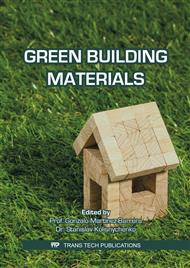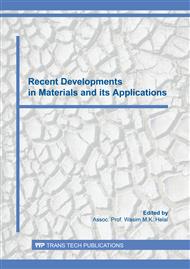[1]
T Karak, R. M. Bhagat and P. Bhattacharyya, Municipal solid waste generation, composition, and management: the world scenario, Critical Reviews in Environmental Science and Technology, 42 (2012) 1509-1630.
DOI: 10.1080/10643389.2011.569871
Google Scholar
[2]
A.V Shekdar, Sustainable solid waste management: An integrated approach for Asian countries. Waste Manage. 29 (2009), 1438.
DOI: 10.1016/j.wasman.2008.08.025
Google Scholar
[3]
O. Olofinnade, S. Chandra and P. Chakraborty, Recycling of high impact polystyrene and low-density polyethylene plastic wastes in lightweight based concrete for sustainable construction, Materials Today: Proceedings, (2020). https://doi.org/10.1016/j.matpr.2020.05.176.
DOI: 10.1016/j.matpr.2020.05.176
Google Scholar
[4]
M. Frigione. Recycling of PET bottles as Fine aggregate in concrete. Waste Manag. 30 (2010) 1101-1106.
DOI: 10.1016/j.wasman.2010.01.030
Google Scholar
[5]
K.J Appiah, V.N Berko-Boateng, and A.T Tagbor, Use of waste plastic materials for road construction in Ghana Case Studies in Construction Materials 6(2017) 1–7 https://doi.org/10.1016/j.cscm.2016.11.001.
DOI: 10.1016/j.cscm.2016.11.001
Google Scholar
[6]
J. Stoler, J.R Weeks and G. Fink, Sachet drinking water in Ghana's Accra-Tema metropolitan area: past, present, and future. J. Water Sanit. Hyg. Dev. 2(2012), 223–240.
DOI: 10.2166/washdev.2012.104
Google Scholar
[7]
D. de Mello, S.H. Pezzin and S.C Amico, The effect of post-consumer PET particles on the performance of flexible polyurethane foams. Polymer Testing 28(2009), 702–708.
DOI: 10.1016/j.polymertesting.2009.05.014
Google Scholar
[8]
P. Sukontasukkul and C. Chaikaew, Properties of Concrete Pedestrian Block Mixed with Crumb Rubber, Construction and Building Materials 20(2006), 450–457.
DOI: 10.1016/j.conbuildmat.2005.01.040
Google Scholar
[9]
Y.W. Choi, D. J Moon, J.S Chung, and S.K Cho, Effects of waste PET bottles aggregate on the properties of concrete Cem. Concr. Res. 35 (2005), 776–781.
DOI: 10.1016/j.cemconres.2004.05.014
Google Scholar
[10]
O.M Olofinnade, J.M Ndambuki, A.N Ede, and C. Booth, Application of waste glass powder as a partial cement substitute towards more sustainable concrete production. Int J Eng Res Afr 31(2017), 77–93.
DOI: 10.4028/www.scientific.net/jera.31.77
Google Scholar
[11]
O.M Olofinnade, A.N Ede, and J.M Ndambuki, Experimental Investigation on the Effect of Elevated Temperature on Compressive Strength of Concrete Containing Waste Glass Powder. Int J of Eng. Tech Inno 7(2017), 280 - 291.
Google Scholar
[12]
A.F Avila and M.V Duarte, A mechanical analysis on recycled PET/HDPE Composites Polym. Degrad. Stabil. 80 (2003) 373–82.
Google Scholar
[13]
T.R Naik, S.S Singh, C.O Huber and B.S Brodersen, Use of post-consumer waste plastic in cement-based composites, Cem. Concr. Res. 26(1996), 1489-1492.
DOI: 10.1016/0008-8846(96)00135-4
Google Scholar
[14]
R. Baboo, S. Tabin-Rushad, K.R. Bhavesh, and S.K Duggal, Study of waste plastic mix concrete with plasticizer International Scholarly Research Network, ISRN Civ Eng. (2012), 1–5.
DOI: 10.5402/2012/469272
Google Scholar
[15]
L. Ferreira, J. De Brito, and N. Saikia, Influence of curing conditions on mechanical performance of concrete containing recycled plastic aggregate, Constr Build Mater, 36(2012) 196–204.
DOI: 10.1016/j.conbuildmat.2012.02.098
Google Scholar
[16]
B. Safi, M. Saidi, D. Aboutaleb, and M. Maallem, The use of plastic waste as fine aggregate in the self-compacting mortars: Effect on physical and mechanical properties, Construction and Building Materials 43(2013) 436–42.
DOI: 10.1016/j.conbuildmat.2013.02.049
Google Scholar
[17]
R. Siddique, J. Khatib, and I. Kaur, Use of recycled plastic in concrete: a review Waste Manage. 28 (2018), 1835–52.
DOI: 10.1016/j.wasman.2007.09.011
Google Scholar
[18]
V. Malagaveli, Strength characteristics of concrete using solid waste an experimental investigation, Int. J. Earth Sci. Eng. 4 (2011), 937-940.
Google Scholar
[19]
K. Ramadevi, and R. Manju, Experimental investigation on the properties of concrete with plastic PET (bottle) fibers as fine aggregate, Int. J. Emerg. Technol. Adv. Eng. 2(2012) 42-46.
Google Scholar
[20]
F. Pelisser, R.K.O Montedo, J.P.P Gleize and R.H. Roman, Mechanical properties of recycled PET fibers in concrete. Mater. Res. 15(2012) 679-686.
DOI: 10.1590/s1516-14392012005000088
Google Scholar
[21]
E. Rahmani, M. Dehestani, M.H.A. Beygi, H. Allahyari, I.M Nikbin, On the mechanical properties of concrete containing waste PET particles. Constr. Build. Mater. 47(2013) 1302-1308.
DOI: 10.1016/j.conbuildmat.2013.06.041
Google Scholar
[22]
M.C Prahallada and K.B. Parkash, Effect of different aspect ratio of waste plastic fibers on the properties of fiber reinforced concrete an experimental investigation Int. J. Adv. Res. IT Eng. 2(2013) 1-13.
Google Scholar
[23]
BS EN 197-1 Composition, specification and conformity criteria for common cement, British Standard Institute, London, (2000).
Google Scholar
[24]
NIS 444-1 Composition, specification and conformity criteria for common cement, Standards organisation of Nigeria, Abuja, (2003).
Google Scholar
[25]
BS EN 1097-3, Tests for mechanical and physical properties of aggregates. Determination of loose bulk density and voids, British Standard Institute, London, (1998).
DOI: 10.3403/01435224
Google Scholar
[26]
BS 3148, Methods of test for water for making concrete (including notes on the suitability of the water), British Standard Institute, London, (1980).
Google Scholar
[27]
Nigerian Building Code, Federal Republic of Nigeria: National Building Code, Abuja 1st ed. (2006).
Google Scholar
[28]
BS EN 772-11, Methods of test for masonry units. Determination of water absorption of aggregate concrete, autoclaved aerated concrete, manufactured stone and natural stone masonry units due to capillary action and the initial rate of water absorption of clay masonry units, British Standard Institute, London, (2011).
DOI: 10.3403/30215381
Google Scholar
[29]
BS 6073-2, Precast concrete masonry units. Guide for specifying precast concrete masonry units, British Standard Institute, London, (2008).
DOI: 10.3403/30168067
Google Scholar
[30]
U.G. Eziefula, H.E. Opara and C.U Anya, mechanical properties of palm kernel shell concrete in comparison with periwinkle shell concrete Malaysian Journal of Civil Engineering 29(2017) 1-14.
Google Scholar
[31]
R.K. Dhir and N. Jackson, Civil Engineering Materials 5th ed. Palgrave (1996) 161-298.
Google Scholar
[32]
M.S Islam and N. Ghafoori, Evaluation of Alkali-Silica Reactivity Using Aggregate Geology, Expansion Limits of Mortar Bars and Concrete Prisms, and Kinetic Model, Journal of Materials Science Research, 2(2013) 103-117.
DOI: 10.5539/jmsr.v2n2p103
Google Scholar
[33]
ASTM C330 – 04 Standard Specification for Lightweight Aggregates for Structural Concrete, American Society for Testing and Materials, West Conshohocken, (2004).
Google Scholar
[34]
J.K Prusty and S.K Patro, Properties of fresh and hardened concrete using agro-waste as partial replacement of coarse aggregate – A review Construction and Building Materials 82(2015) 101–113.
DOI: 10.1016/j.conbuildmat.2015.02.063
Google Scholar
[35]
BS 2028, Specification for Precast Concrete Blocks , British Standard Institution, London, (1968).
Google Scholar
[36]
J.O Akinyele and I.O Toriola, The effect of crushed plastics waste on the structural properties of sandcrete blocks, African Journal of Science, Technology, Innovation and Development (2018), 1–5.
DOI: 10.1080/20421338.2018.1496614
Google Scholar
[37]
Nigerian Building and Road Research Institute (NBRRI), NBRRI Interlocking Block making Machine, NBRRI Newsletter, 1(2006), 15 – 17.
Google Scholar
[38]
NIS 87, Standard for Sandcrete Blocks, Nigerian Industrial Standard, Abuja, (2007).
Google Scholar
[39]
A.A Raheem and O.K Sulaiman, Saw Dust Ash as Partial Replacement for Cement in the Production of Sandcrete Hollow Blocks. International Journal of Engineering Research and Applications, 3(2017) 713–721.
Google Scholar
[40]
S.O Odeyemi, O.O Otunola, A.O Adeyemi, W.O Oyeniyan, and M.Y Olawuyi, Compressive strength of manual and machine compacted sandcrete hollow blocks produced from brands of Nigerian cement American Journal of Civil Eng. 3(2015) 2-3.
Google Scholar



